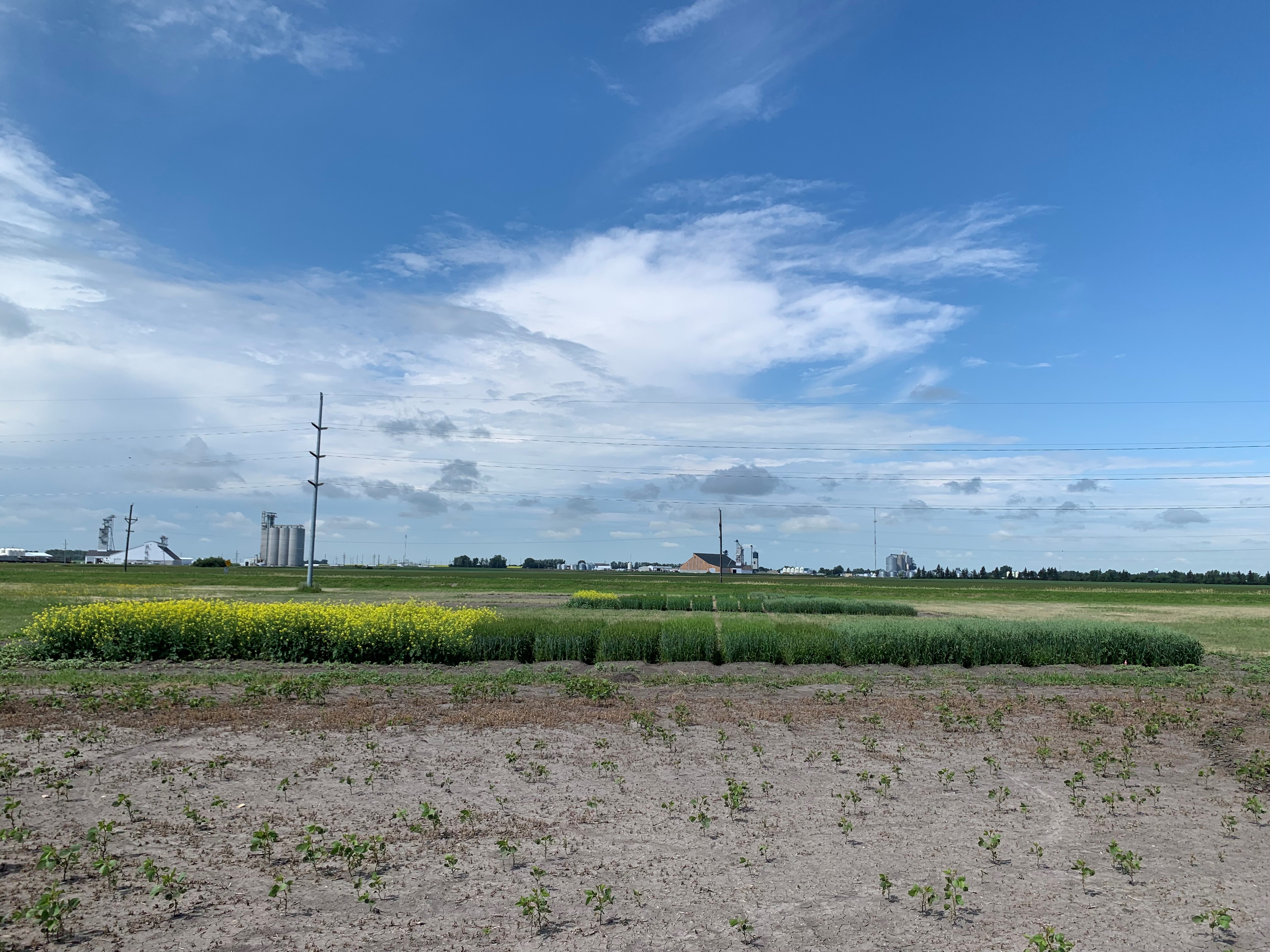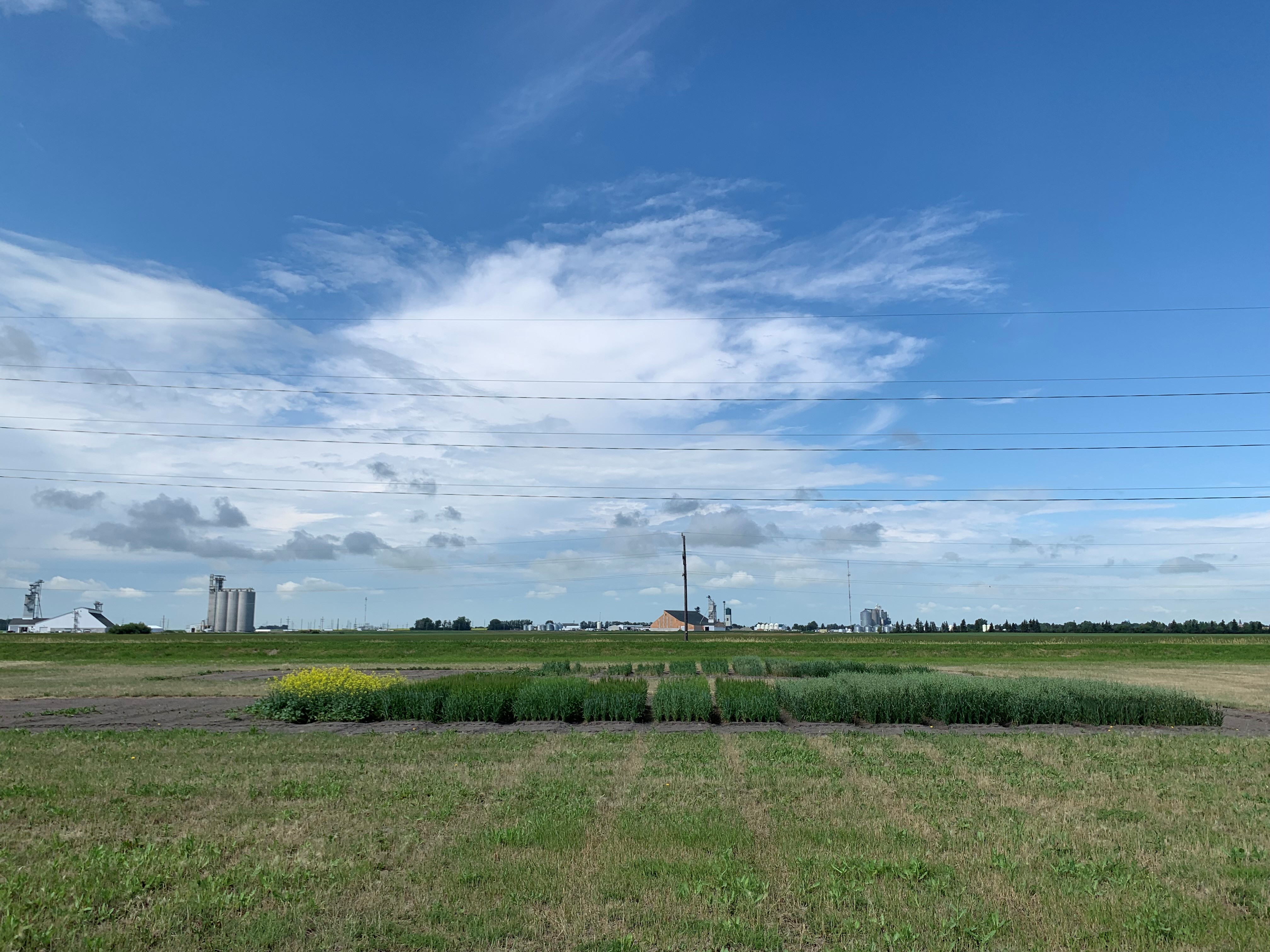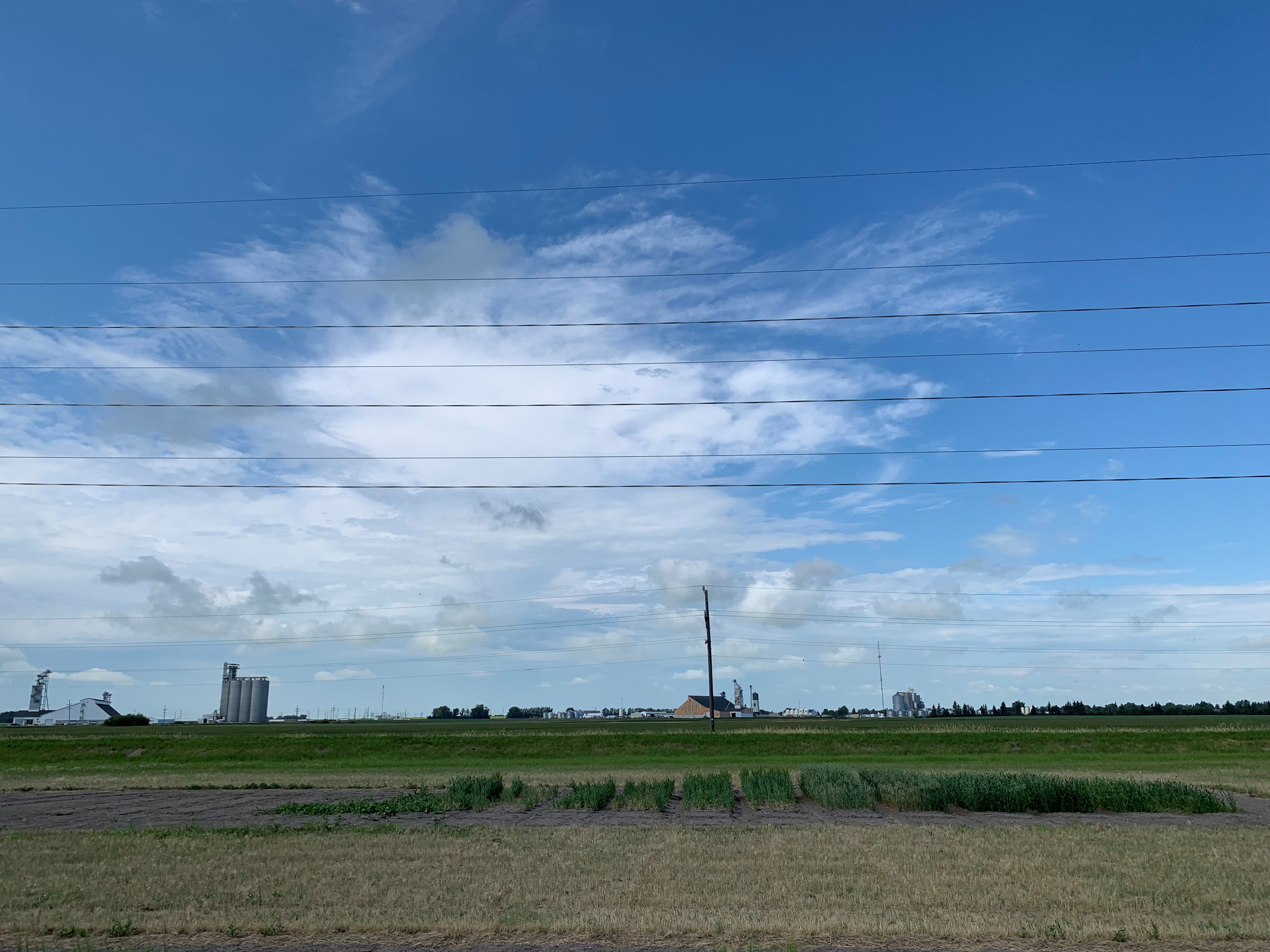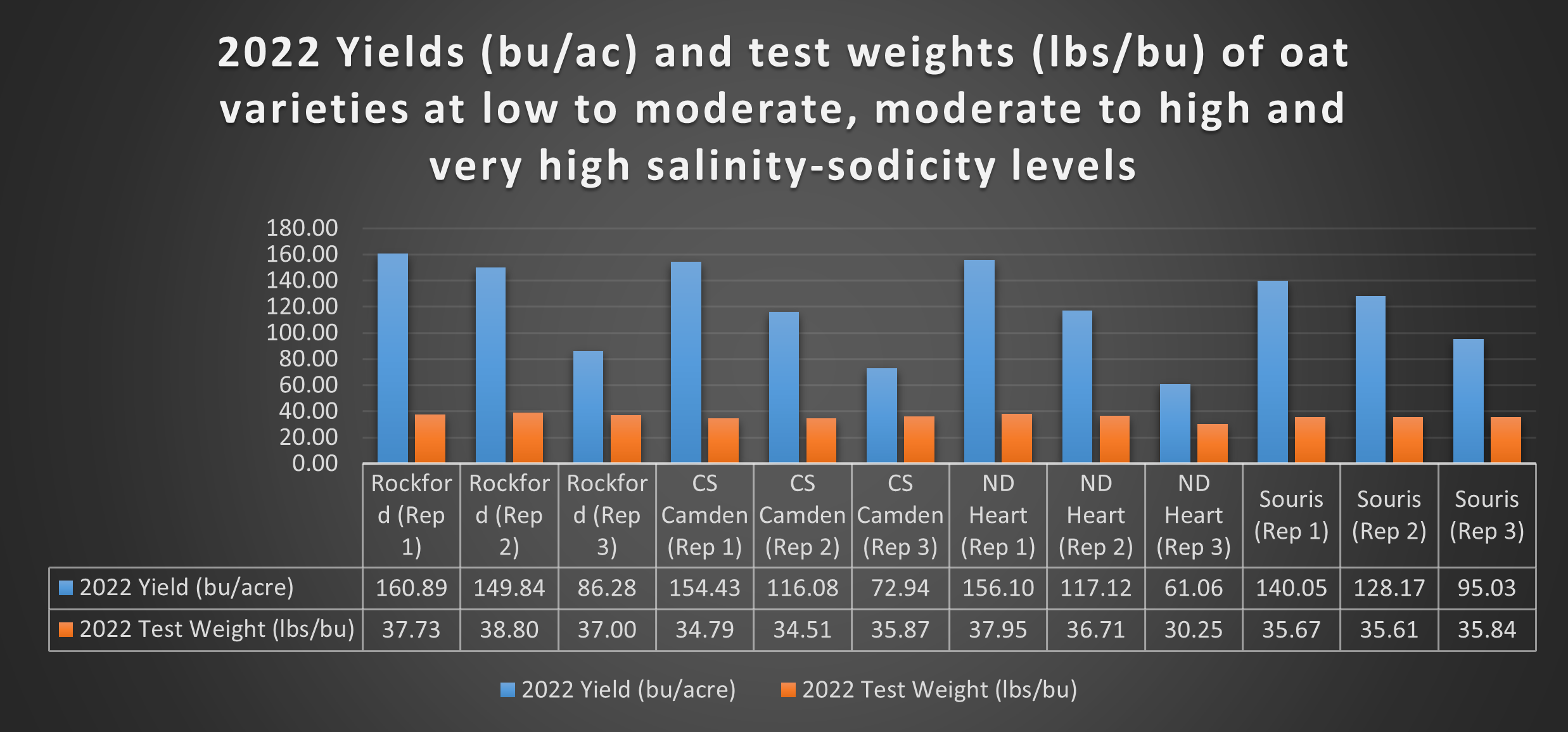Barley and oats are some of the most salt and sodicity tolerant annual crops producers can profitably grow in North Dakota. However, at certain salinity and sodicity levels, even barley and oats can result in significant losses. Especially important are the levels of salinity and sodicity in the top six inches of the soils. Sensing the need to determine the economic threshold of soil salinity (Electrical Conductivity or EC) and sodicity (Sodium Adsorption Ratio or SAR) for barley and oats, four barley and four oat varieties were planted at the Langdon REC site in 2022 at three different levels of salinity and sodicity. This trial was a repeat of 2020 and 2021 trials. In addition, four canola varieties were added to the trial in 2022 to compare salinity and sodicity tolerances of the canola crop versus barley and oats.
Soil Analysis Results
Two-foot deep composite soil samples separated into 0-6 and 6-24 inch depths were taken on June 9, 2022 by taking three cores for each sample. The three levels of salinity and sodicity were described as replications 1, 2 and 3 and were sampled separately. Replication 1 was described as having low to moderate levels of salinity and sodicity, replication 2 having moderate to high levels and replication 3 having very high levels. These descriptions were based on the salinity and sodicity tolerance of crops like barley and oats. These levels would be considered high for sensitive crops such as soybean. Soil EC, SAR and pH were analyzed by using the saturated paste extract method (Table 1).
Table 1. The 2020, 2021 and 2022 soil EC, SAR and pH results of the three replications for the 0-6 and 6-24 inch depths.
| | | | EC (dS/m) | EC (dS/m) | EC (dS/m) | SAR | SAR | SAR | pH | pH | pH |
|---|
| Site | Sample ID | Depth (inches) | 2020 | 2021 | 2022 | 2020 | 2021 | 2022 | 2020 | 2021 | 2022 |
| Rep 1 | Low to moderate salinity-sodicity | 0-6 | 3.99 | 4.63 | 1.64 | 7.12 | 6.20 | 4.95 | 7.18 | 7.54 | 7.40 |
| 6-24 | 7.32 | 7.49 | 6.70 | 15.05 | 14.72 | 15.50 | 7.71 | 7.97 | 7.80 |
| Rep 2 | Moderate to high salinity-sodicity | 0-6 | 7.80 | 13.20 | 7.92 | 18.13 | 22.88 | 16.28 | 7.61 | 8.17 | 7.80 |
| 6-24 | 10.39 | 12.29 | 11.03 | 20.92 | 21.14 | 39.54 | 7.95 | 8.21 | 8.00 |
| Rep 3 | Very high salinity-sodicity | 0-6 | 10.50 | 14.90 | 11.21 | 27.30 | 32.74 | 30.00 | 7.59 | 8.14 | 7.80 |
| 6-24 | 9.86 | 12.98 | 11.10 | 32.87 | 32.04 | 31.83 | 7.81 | 8.16 | 8.00 |
The main difference in salinity and sodicity levels between the three replications has been the 0-6 inch depth of replication 1 had low to moderate levels, whereas, replication 2 and 3 have had moderate to high levels in 0-6 and 6-24 inch depths. In addition, 6-24 inch depth of replication 1 had moderate to high salinity and sodicity levels. The lower salinity and sodicity levels in replication 1, 0-6 inch depth and corresponding germination, stands, yields and quality in 2020-2022 indicate the levels of salinity and sodicity in the surface layers matter more than the subsurface layers.
Annual snowfall, resulting spring-melt and rainfall in spring and early growing-season also had an impact on salinity and sodicity, especially in the 0-6 inch depths. Weather wise, 2020 was a normal year, 2021 was very dry (spring and early growing-season) and 2022 was very wet (spring and early growing-season). Dry weather in 2021 resulted in a slight increase in EC, whereas, wet weather lowered EC levels in 2022, especially in replication 1, 0-6 inch depth. Lower EC levels combined with high moisture availability in 2022 spring and early growing-season resulted in improved germination, stands and higher yields even at higher salinity and sodicity levels compared to 2020 and 2021.
Trial Design, Plot Sizes, Planting and Harvesting Details
Trial design was randomized split block and plot sizes were 4.7 X 22 feet. Details are in Table 2.
Table 2. 2022 barley, oat and canola varieties, planting dates, seeding rates and fertilizer rates per acre, planting depths, and harvest dates.
| Crop | Variety | Planting Date | Seeding Rates (live seeds/acre) | Seeding Depth (inches) | Fertilizer Application (lbs./acre) | Harvest Date |
|---|
| 2022 Planting Details |
| Barley | AAC Synergy (2-row) | June 10, 2022 | 1.0 million live seeds per acre | 1 to 1.5 | Due to a very short growing-season and inability to soil sample early, a uniform rate of 120 pounds of nitrogen and 30 pounds of P2O5 was applied to all three replications the morning of June 10, 2022 by using Urea and MAP. | Straight combined on September 14, 2022 (desiccated on September 8, 2022) |
| ND Genesis (2-row) |
| Lacey (6-row) | 1.25 million live seeds per acre |
| Tradition (6-row) |
| Oats | CS Camden | 1.0 million live seeds per acre |
| ND Heart |
| Rockford |
| Souris |
| Canola | L345PC | 0.4356 million live seeds per acre (10 seeds per square foot) | Straight combined on September 22, 2022 (desiccated on September 14, 2022) |
| L340PC |
| DKTFLL21SC |
| LR344PC |
Results and Discussion
Similar to 2020 and 2021, there were differences between the three replications in seedbed, germination, plant growth and vigor, maturity, yield, and quality.
Differences in Seedbed
In 2022 the seedbed turned rough and cloddy with the increase in soil sodicity (replication 2 and 3). This effect was slightly less in 2022 compared to 2021 and 2020. That could be due to the annual tillage that was performed in 2020-2022. See seedbed pictures 1-3 below for comparisons.






